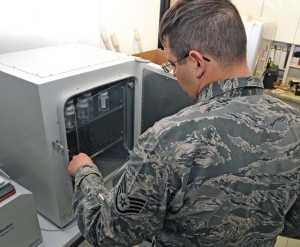
The 86th Aerospace Medical Squadron’s bioenvironmental engineering flight works to provide better health and wellness to members here by performing risk assessment tests for facilities and planning documents for chemical, physical, and biological stress factors which may cause illness to ensure a healthy work environment.
The 86th AMDS conducts inspections on a number of facilities on base. They take water samples on a weekly basis, ensure confined spaces have the correct oxygen levels, prevent hazardous noise, take air samples and conduct surveys to test for radiation.
They do these tests to ensure there are not high levels of chemical, radiological or biological contaminates polluting the environment or becoming a problem for members of the KMC.
“We analyze occupational health hazards and maintain longitudinal exposure records,” said Staff Sgt. Michael Fitzgibbons, 86th AMDS bioenvironmental engineering technician. “It’s extremely
important that we provide a high level of confidence in the protection we provide to the KMC
population.”
The bioenvironmental engineering technicians go to technical training for three and a half months to train
for real-world situations that could arise.
Their training consists of exercises that teaches them how to handle and dispose of hazardous wastes and how to properly clean chemical spills.
“Our training is serious,” said Airman 1st Class Eric Roberts, 86th AMDS bioenvironmental engineering technician. “It’s ideal since we do a lot of work with occupational health, and we always need to be prepared for any situation.”
If an area is deemed hazardous, bioenvironmental engineering technicians recommend a solution, ranging from changing the process to implementing workplace controls.
“Keeping all the workers safe — if we can accomplish this, we can continue the mission in an efficient manner,” Roberts said.
Ramstein’s bioenvironmental engineering flight has the same safety procedures as any base in the states with one addition, they must comply with the host nation requirements to make sure their codes and standards are met as well.
Keeping the KMC safe is a major priority, however, Airmen from the bioenvironmental engineering flight have another long-term goal in mind when they come to work every day.
Our efforts in helping keep KMC members and their families safe is important, but the prevention of damage to resources is crucial, Fitzgibbons said.
Additional questions can be directed to the 86th AMDS Bioenvironmental Engineering flight at 479-2220 and 06371-46-2220.


